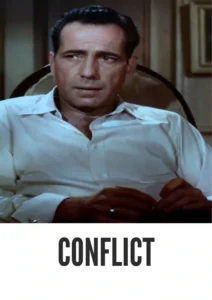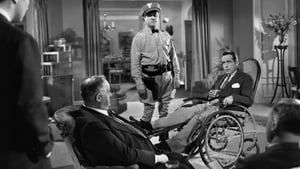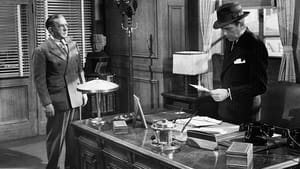Contact: info@alwanfilm.com
Video Sources 0 Views
- Watch trailer
- Conflict


Conflict 1945 Colorized
Synopsis
Table of Contents
ToggleReview: Conflict 1945 Colorized – A Taut Psychological Thriller

Introduction
Conflict, released in 1945, is a captivating psychological thriller directed by Curtis Bernhardt. Renowned for its taut suspense, intricate plotting, and standout performances, this classic film continues to intrigue audiences with its exploration of jealousy, obsession, and betrayal. In this review, we’ll delve into the dark and suspenseful world of Conflict and its enduring legacy in the realm of film noir.
Check The Full Colorized Movies List
Check Our Colorized Movies Trailer Channel
Understanding Conflict 1945 Colorized: Director, Cast, and Genre
Directed by Curtis Bernhardt, Conflict boasts a talented cast led by Humphrey Bogart, Alexis Smith, and Sydney Greenstreet. The film belongs to the film noir genre, known for its atmospheric cinematography, morally ambiguous characters, and shadowy themes.
Exploring the World of Conflict 1945 Colorized: Plot and Characters
Conflict follows the story of Richard Mason, a wealthy and seemingly content man who becomes consumed by jealousy when he suspects his wife, Kathryn, of having an affair. As Richard’s suspicions escalate into paranoia, he becomes increasingly unhinged, leading to a series of shocking revelations and tragic consequences. Against the backdrop of post-war America, the film explores themes of love, betrayal, and the dark depths of the human psyche.
The Art of Film Colorization
While Conflict was originally filmed in black and white, its early colorized version adds a new layer of depth to its atmospheric visuals. The colorization process enhances the film’s moody atmosphere and captures the nuances of its shadowy characters with striking clarity.
Early Colored Films: A Brief History
The history of early colored films is marked by innovation and experimentation as filmmakers sought to enhance the visual appeal of their movies. From hand-tinted frames to pioneering technicolor processes, the evolution of colorization techniques transformed the cinematic landscape, offering audiences a new way to experience the darkness and intensity of film noir.
Conflict (1945) and Its Early Colored Version
The decision to release Conflict in a colorized format was made with the intention of immersing audiences in the film’s atmospheric cinematography and enhancing its visual impact. While some purists may prefer the original black and white version, the early colorized edition of Conflict adds a new layer of depth to its moody atmosphere and captures the psychological complexity of its characters with breathtaking clarity.
The Debate Over Film Colorization
The debate over film colorization continues to divide audiences and industry professionals alike. While some argue that colorization breathes new life into classic films and makes them more accessible to modern audiences, others maintain that it compromises the artistic integrity of the original work. As technology advances and filmmaking techniques evolve, the debate over colorization remains a topic of ongoing discussion within the film community.
Examining Conflict (1945) as an Early Colored Film
Viewing Conflict in its early colorized iteration offers audiences a fresh perspective on its atmospheric visuals and psychological depth. The colorization process enhances the film’s moody atmosphere and captures the complexity of its characters with stunning clarity. As viewers are drawn into Richard Mason’s descent into jealousy and madness, they are treated to a visual feast that immerses them in the dark and suspenseful world of film noir.
Influence and Legacy: Conflict 1945 Colorized’s Impact on Cinema
Conflict is widely regarded as a standout example of the psychological thriller genre, with its taut suspense and compelling storyline earning it a place among the classics of film noir. Its exploration of jealousy, obsession, and betrayal continues to resonate with audiences, making it a timeless classic that remains relevant to this day.
Director’s Cinematic Legacy: Beyond Conflict 1945 Colorized
Curtis Bernhardt’s directorial legacy extends far beyond Conflict, encompassing a diverse body of work that includes acclaimed films such as Possessed and A Stolen Life. As one of the most innovative filmmakers of his generation, Bernhardt was known for his ability to craft visually stunning films that explored the complexities of the human condition with depth and nuance. Conflict stands as a testament to his talent and creativity, solidifying his reputation as one of the great auteurs of classic Hollywood cinema.
Themes Explored in Conflict 1945 Colorized
At its core, Conflict explores the destructive power of jealousy and obsession in the human psyche. Through its tense atmosphere and morally ambiguous characters, the film offers a chilling portrayal of the dark depths of the human mind, challenging viewers to confront their own fears and desires as they unravel the mystery at its heart.
Reception and Controversy Surrounding Conflict 1945 Colorized
Upon its release, Conflict received widespread critical acclaim for its taut suspense, intricate plotting, and standout performances. While the decision to release the film in a colorized format sparked debate among purists, its enduring popularity has cemented its status as a timeless classic of the psychological thriller genre.
Where to Watch Conflict 1945 Colorized Online
For those eager to experience Conflict for themselves, the film is readily available on popular streaming platforms such as Amazon Prime Video, Google Play Movies, and iTunes. Whether viewed in its original black and white format or its early colorized iteration, Conflict offers a cinematic experience that is both suspenseful and visually stunning.
FAQs About Conflict 1945 Colorized
1. Is Conflict based on a true story?
No, Conflict is a fictional film that explores the dark and suspenseful world of jealousy and obsession through the eyes of its troubled protagonist, Richard Mason. While the film’s storyline may draw inspiration from real-life events, its characters and plot are works of fiction.
2. Who starred in Conflict?
Conflict stars Humphrey Bogart in the role of Richard Mason, a wealthy man consumed by jealousy and obsession. He is supported by Alexis Smith as his wife, Kathryn, and Sydney Greenstreet as Dr. Mark Hamilton, a psychiatrist who becomes entangled in Richard’s web of deceit.
3. What is the central message of Conflict?
At its core, Conflict explores the destructive power of jealousy and obsession in the human psyche. Through its tense atmosphere and morally ambiguous characters, the film offers a chilling portrayal of the dark depths of the human mind, challenging viewers to confront their own fears and desires as they unravel the mystery at its heart.
4. Why was Conflict released in a colorized format?
The decision to release Conflict in a colorized format was made with the intention of immersing audiences in the film’s atmospheric cinematography and enhancing its visual impact. While some purists may prefer the original black and white version, the early colorized edition of Conflict adds a new layer of depth to its moody atmosphere and captures the psychological complexity of its characters with breathtaking clarity.
5. What is the legacy of Conflict?
Conflict is widely regarded as a standout example of the psychological thriller genre, with its taut suspense and compelling storyline earning it a place among the classics of film noir. Its exploration of jealousy, obsession, and betrayal continues to resonate with audiences, making it a timeless classic that remains relevant to this day.
6. Are there any sequels or remakes of Conflict?
No, there have been no official sequels or remakes of Conflict. However, the film’s enduring popularity has inspired countless reinterpretations and homages in various media. Nonetheless, none have captured the suspense and psychological depth of the original 1945 classic.
7. Where can I watch Conflict online?
For those eager to experience Conflict for themselves, the film is readily available on popular streaming platforms such as Amazon Prime Video, Google Play Movies, and iTunes. Whether viewed in its original black and white format or its early colorized iteration, Conflict offers a cinematic experience that is both suspenseful and visually stunning.
Conclusion
In conclusion, Conflict (1945) stands as a taut and gripping psychological thriller that continues to captivate audiences with its intricate plotting, standout performances, and atmospheric cinematography. Whether viewed in its original black and white format or its early colorized iteration, Curtis Bernhardt’s insightful direction and the stellar performances of the cast offer a cinematic experience that is both suspenseful and visually stunning. As viewers are drawn into the dark and suspenseful world of Richard Mason, they are treated to a visceral journey that challenges their beliefs about love, obsession, and betrayal. Conflict remains a timeless classic that continues to enthrall and inspire audiences around the world.












